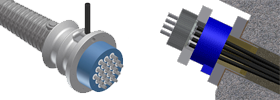Infrastructure for energy
Increasingly environmentally-friendly solutions are required from the construction industry, while the practicalities and associated costs must be weighed by infrastructure owners. There are some compelling advantages for choosing BBR technology. Sectors include wind energy, LNG/LPG and nuclear – where the expertise of the BBR Network has made a significant and sustained contribution.
 |
Wind tower technology & techniques
Post-tensioned concrete plays an important role in realizing the full potential of wind energy. Concrete tower solutions are adaptable and durable and offer long life performance with minimum maintenance. The use of precast or in-situ post-tensioned concrete, rather than steel, in the construction of windfarms offers several advantages to owners and operators:
- Reduced maintenance costs and long-life performance – through comparative durability of concrete over steel
- Up to 15% higher energy production – post-tensioned concrete pylons can be 30-40m higher
- Lower transportation costs – casting is not highly specialized and can be carried out near the site
- Design and construction flexibility – versatility of concrete enables design solutions with no restrictions on height or size
- Dynamic performance – post-tensioned concrete has inherently high damping properties and can deliver fatigue resistant solutions with lower noise emissions
Taller wind towers need greater structural strength and stiffness to carry both the increased turbine weight and bending forces from wind action on the rotors and the tower and also to avoid damaging resonance. The move towards taller wind towers is tipping the balance towards PT concrete design solutions with their many advantages.
CONA CMB band products and CONA CMG ground anchors, amongst others, are well-suited to the construction of windfarms.
Meeting demand for LNG/LPG storage
 |
To cater for the increasing demand for Liquefied Natural Gas (LNG) and LPG, many new facilities are being developed around the world – and BBR technologies and expertise have been instrumental in their realization.
LNG is stored in cryogenic conditions at -162°C within specially engineered and constructed double-walled storage tanks, in cryogenic conditions at -162ºC. At these very low temperatures, the requirements for the containment structures are very stringent and post-tensioned concrete tanks are ideally suited to the task. The large concrete tank structures are extremely robust with significant amounts of prestressing required – all being designed and installed under tightly controlled quality conditions, with hardware requiring special certifications.
Design and construction techniques have been specially formulated for LNG tank construction. The outer walls of the tank are most commonly constructed from post-tensioned concrete. The void between the tank's double walls is filled with insulation. Tanks are around 80-90m in diameter and 50m high, with a wall thickness of some 750mm. The post-tensioning tendons are very large and typically run both vertically and horizontally.
LNG storage tanks are ideally suited to construction methods employing slipformed or climbing insitu concrete construction combined with post-tensioning. The design and installation techniques are very specialized and require specially certified and tested materials – such as the CONA CMI system for cryogenic applications – and highly experienced contractors.
Energized for the future
The recognised adaptability and reliability of BBR prestressing systems for the post-tensioning of nuclear power plant pressure and containment vessels has made them some of the best known internationally. The BBR team has now completed more then 60 nuclear energy projects in 15 countries.
BBR engineers were pioneers in the development of high capacity tendons for nuclear applications. As early as the 1960s, they constructed a special facility at the tendon assembly plant in Switzerland to test the first generation of large tendons for nuclear power plants.
The basic structural design is generally a cylindrical vessel with flat end slabs or a convex dome. Practically all recent nuclear structures consist typically of two shells, the inner and the outer containment. BBR post-tensioning tendons such as the high-capacity CONA CMI internal range with up to 73 strands are typically used in the inner containment and consist of three types:
- Vertical tendons for wall post-tensioning
- Horizontally looped tendons (hoop tendons)
- Cane shaped tendons
For the continuous safety of service of large tendons, accurate measurement of the stressing force and regular controls are of great importance. For many years now, BBR Network Members have been carrying out lift-off tests.
Technologies used
LNG/LPG References
Tailored, Certified & Reliable
See our Downloads page
BBR Nuclear Tendons
Powerful and trusted technology
See our Downloads page




